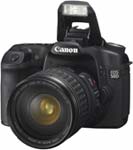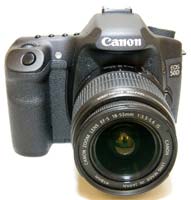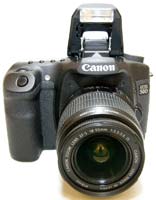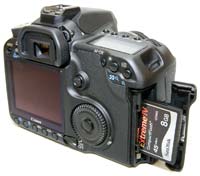Canon EOS 50D Review
Review Date: October 2nd 2008
Author: Mark Goldstein
Leave a comment about this Review
|
Introduction

Overshadowed by the protracted launch of the long-awaited full-frame 5D Mark II, the new semi-pro Canon EOS 50D DSLR camera was quietly announced at the end of August. Successor to the one year old 40D, this new model looks virtually identical on the outside, but offers a number of important improvements inside to either tempt you to upgrade from the 40D, or invest in the Canon system. Most notable are the 15.1 megapixel CMOS sensor, up from 10 megapixels on the 40D and the highest-ever for an APS-C sensor camera, an expanded ISO range of 100-12800, which matches the Nikon D700 / D3, the debut of the latest DIGIC 4 image processor, a new Live View mode with Face Detection, HDMI connectivity and a high-resolution 3.0� LCD screen with 920K dots. A new Quick Control screen lets you adjust various camera settings via the LCD monitor, the Auto Lighting Optimizer analyzes the brightness of subjects and automatically adjusts dark images so that they appear brighter, and the AF Microadjustment feature promises to banish back- and front-focusing issues for good. With a price-tag of �1200 / $1399 body only, Canon 50D is both a serious investment for advanced amateurs and affordable backup for professionals. Read our review to find out if the Canon EOS 50D can meet your requirements.
Compare Prices
Support PhotographyBLOG: Buy the Canon EOS 50D from one of our affiliate retailers:Ease of Use
The Canon EOS 50D is outwardly almost identical to its predecessor, the EOS 40D, having the same dimensions (145.5 x 107.8 x 73.5mm), and weighing 10g less at 730g without a lens fitted. Where cheaper entry-level DSLR cameras use plastics, the 50D has a magnesium alloy body which should make it more durable in the long term. The finish seems tough and resilient too, and the memory card and battery doors are dust and moisture resistant, making the 50D potentially better suited to hostile environments, whether they're encountered on a photo shoot in the Himalayas or a trip to the seaside. There's a textured area on both the deep hand-grip and around the thumb-rest on the rear of the camera, and unlike the cheaper 450D and 1000D models, this camera is perfect for everyone with normal to large-sized hands. The most obvious external differences between the 5D and the 40D are the addition of a HDMI port on the left of the body, the top of the mode dial is silver rather than black, and there's a much brighter, higher-resolution LCD screen on the rear (offering 4x the resolution of the 40D's screen).
On more basic SLRs, adjustments are usually made using a combination of buttons and a single control wheel. This is fine for novices, but awkward for experienced photographers who want to be able to adjust a combination of exposure, shutter speed or aperture quickly. Like other semi-pro cameras, the Canon EOS 50D offers two control wheels; a small one on the top of the handgrip, and a large, spinning dial on the back of the camera. This rear 'quick control dial' is characteristic of all high-end Canon EOS cameras. It's a bit of an acquired taste compared to more conventional control dials, but you quickly get used to it and it is easy to 'spin'. The power switch has a third position which activates this dial, and you can then use it to apply rapid exposure adjustments. The quick control dial does take up the space where you'd normally expect to find a four-way controller, which means that for menu navigation Canon has had to incorporate an additional small joystick on the back of the camera. This joystick works well enough, but it's not as positive or as easy to use as a conventional four-way controller. On the 50D, Canon has extended the joystick's capabilities; pressing it in opens the new Quick Control screen. Depending on which shooting mode you're using, this lets you set various parameters via the LCD screen, using the joystick to move around the various options. Similar to the system that Sony Alpha DSLRs have used for a while, the Quick Control screen is particularly well-suited to beginners and tripod work.
On top of the Canon EOS 50D, positioned above the status LCD display, are three buttons, each of which has two functions. You press a button and then turn either the top dial or the rear dial to change the corresponding setting. It does take a little while to memorise which button does what, and which dial you need to turn, although the 50D now also shows the settings on the main LCD screen as well as the status LCD. Having said that, the Canon EOS 50D is not an 'occasional' camera that's going to be brought out only for special occasions or outings. A camera like this is likely to get heavy, frequent use, and its controls will soon become second nature, and the unusual layout does make routine adjustments very straightforward. There are two LCD displays on this camera; the 3-inch colour LCD on the rear and the smaller status panel on the top. On cheaper cameras, the LCD on the rear usually has to do both jobs, but on this model all the camera settings are visible from above on the smaller panel. This can make the Canon EOS 50D quicker to use, and it may also extend the battery life. The main LCD screen has been significantly improved, now offering a fantastic VGA resolution with 920K dots, so you may find yourself using it more often than you thought. Importantly it also brings the EOS 50D in line with its main competitors, and it also allows you to judge the critical sharpness of your photos using the LCD screen, which has been a long-standing issue on Canon's entry- and mid-range DSLRs.
Like most DSLRs aimed at beginners and amateurs, the EOS 50D provides a number of auto shooting modes aimed at beginners, including portrait, landscape, close-up, sports and night portrait and flash off choices. All of these functions performed adequately in all aspects, apart from the close-up macro mode that did not come near to offering a true 1:1 reproduction (you'll need a dedicated macro lens for that). There are, of course, manual and semi-automatic modes for users who want more advanced exposure control. Canon refers to these advanced operations as the 'creative zone' and provides all the normal settings including Program, Aperture and Shutter Priority and the full manual mode. Additionally, they provide the 'A-DEP' (Automatic Depth of Field) function that gives a wider depth of field between a near and far subject, and the brand new Creative Auto mode. This is targeted at beginners who have grown out of using the Full Auto mode, allowing you to change a few key settings using the LCD screen, with a simple slider system for changing the aperture and exposure compensation, or Background and Exposure as the camera refers to them.
 |
 |
| Front | Rear |
Once the EOS 50D is in the 'creative zone', users can adjust the ISO setting into one of eight positions from 100 to 12800 (you need to to enable the ISO 6400 and 12800 modes via the "ISO expansion" custom function option), which is more than adequate for most lighting conditions. The EOS 50D offers a range of three Auto focus modes (One Shot, AI Focus and AI Servo), and there are six preset, auto, kelvin and custom white balance options. The viewfinder displays all key exposure information including ISO speed, and the 50D uses the same 9-point auto-focus system as the 40D. There are four metering modes including a 4% Spot metering mode, useful in tricky lighting conditions as an alternative to the excellent and consistent Evaluative metering system.
The menu system is now the same as on the EOS 450D and 1000D, which in turn borrowed the design from the professional range of EOS cameras. There's a simplified tab structure that does away completely with scrolling, with 9 colour-coded horizontal tabs and up to 7 options in each one, providing quick and easy access to the various options. You can even setup your own customised menu page for instant access to frequently used settings via the My Menu tab. Only the complex Custom Functions menu detracts a little from the overall usability. The documentation that comes with the 50D is very good, as it is with all Canon cameras. You get a detailed manual in English throughout and you'll find everything you need to know about the camera's operation in here, without the need to search through the supplied CDs for an 'electronic' manual.
I tested the EOS 50D with the EFS 18-55mm f/3.5-5.6 IS kit lens, which offers the same focal range as the standard lens that shipped with the previous 40D model, but crucially adds image stabilisation. This is important for Canon, as competitors like Sony, Olympus and Pentax all offer image stabilisation in their DSLRs. The difference between Canon (and Nikon) and the others is that Sony, Olympus and Pentax have opted for stabilisation via the camera body, rather than the lens, which therefore works with their entire range of lenses. Canon's system is obviously limited by which lenses you choose, but it does offer the slight advantage of showing the stabilising effect through the viewfinder. Canon and Nikon also claim that a lens-based anti-shake system is inherently better too, but the jury's out on that one.
The Canon EOS 50D offers fast, positive autofocus, which can track moving subjects very well and which is also near-silent, even with the cheaper 18-55mm kit lens. In fact, there are three body/lens choices with this camera. If you're upgrading from an older or cheaper digital EOS model and already have a lens or lenses, you can buy the 50D body-only. The next-cheapest option is to get it with the EFS 18-55mm lens normally sold with the 450D. This doesn't have a great reputation for quality, but it's better than a lot of people think and the autofocus is very fast and quiet. Perhaps the best option, though, is Canon's 17-85mm IS lens, which offers a wider focal range. It's the more expensive choice, but in the long run it's a better, more versatile lens which fully matches the quality of the 50D itself.
 |
 |
| Top | Pop-up Flash |
The EOS 50D is the first Canon DSLR to feature the new DIGIC 4 processor, which produces noticeably faster image processing, start-up and image review times, and better noise reduction in high-ISO images (jump to the Image Quality page for ISO samples). Despite DIGIC 4, the 50D can't actually shoot any faster than the previous 40D model though, obtaining a speed of 6.3fps for up to 60 full-sized JPEGs or 16 RAW images. If you use a UDMA (Ultra Direct Memory Access) Compact Flash memory card with the 50D, the number of JPEGs increases to 90 images (no increase in the actual burst speed, or the number of RAW files), and it supports transfer speeds up to 133 MB/sec. Unlike the newer and more expensive 5D Mark II, the 50D can't shoot video, but it does have an HDMI port for playing back 1920 x 1080 still images on a HD TV. It uses the industry-standard HDMI mini-out connection, but note that you'll need to purchase a suitable cable separately. You can also still connect the 50D to a standard TV set via NTSC/PAL.
The 50D has a very similar Live View system to the 40D and 450D, additionally offering a new Live AF with Face Detection mode. If you're new to DSLRs and don't understand the terminology, basically Live View allows you to view the scene in front of you live on the LCD screen, rather than through the traditional optical viewfinder. This is an obvious attraction for compact camera users, who are familiar with holding the camera at arm's length and composing via the LCD screen. It's also appealing to macro shooters, for example, as it's often easier to view the screen than look through the viewfinder when the camera is mounted on a tripod at an awkward angle.
Live View is annoyingly difficult to actually turn on, as Canon have inexplicably buried it in the menu system. Once enabled, Live View is activated by pressing the Print button on the rear of the camera to the left of the viewfinder (previously activated via the Set button on the 40D). A grid line display and very useful live histogram can be enabled to help with composition and exposure, and you can zoom in by up to 10x magnification of the image displayed on the LCD screen. Focusing is achieved via the AF-On Lock button, rather than half-pressing the shutter-button. Live View can also be controlled remotely using the supplied EOS utility software, which allows you to adjust settings and capture the image from a PC.
So who does the EOS 50D's Live View mode most appeal to? Well, it attempts to satisfy both the consumer and more technical user, with three types of focusing system on offer. The first, Quick AF, works by physically flipping the camera mirror to engage the auto-focus sensor, which then momentarily blanks the LCD screen and causes a physical sound, before the image is displayed after about 1 second. The other methods, Live AF and Live AF with Face Detection, use an image contrast auto-focus system, much like that used by point-and shoot compacts, the main benefits being the complete lack of noise during operation, and no LCD blackout. Unfortunately these are much slower than the Quick AF mode, taking over 3 seconds to focus on a clearly-defined subject in bright light, which I think will put off most users that are attracted by the promised point-and-shoot experience. On a more positive note, you can move the AF point around the screen, and the 50D successfully detected faces in most situations.
 |
 |
| Memory Card Slot | HDMI Port |
The EOS 50D uses the same dust-removal technology as previous models, where the sensor is shaken briefly at high frequency to dislodge any dust particles from its surface. This could delay the need for manual sensor cleaning, perhaps indefinitely, but it won't be able to remove 'sticky' deposits like salt spray, pollen or the smears left behind by careless sensor cleaning or the wrong kind of solvent. The 50D also inherits the internal Dust Delete Data system from the 40D, which can map the position of visible dust on the sensor. This can then be deleted automatically after the shoot with the supplied Digital Photo Professional software. Or so Canon claim - I found that DPP often refused to even acknowledge the dust particles that had been identified, never mind delete them.
Peripheral Illumination Correction is a new feature that's actually a lot simpler that it initially sounds. Basically it corrects the unwanted effects of vignetting, typically seen in wide-angle photos in the corners of the frame. The 50D contains a database of correction data for 26 Canon lenses and, if Peripheral Illumination Correction is enabled, automatically applies it to JPEG images. For RAW images the correction is applied later in the Digital Photo Professional software. Up to 40 lenses can be programmed into the 50D, with over 80 currently available to choose from. Peripheral Illumination Correction is a useful and effective addition, particularly for JPEG shooters, and can safely be left turned on all of the time. Even more useful, especially if you have a number of older lenses, is the AF Microadjustment feature that has trickled down from the pro Canon EOS-1D Mark III. Very similar to the Pentax K20D's AF Adjustment custom function, it allows you to alter the focus of each lens, then use a focusing target to test if the lens focuses correctly, and if it doesn't alter it slightly using the AF Adjustment option, then test again until perfect focus is achieved. With most other DSLR systems you'd have to send the camera and lens off for calibration (and maybe even have to pay for it), but with the 50D, you can calibrate all of your lenses in the comfort of your own home (up to 20 lenses can be stored in the camera).
Once you have captured a photo, the Canon EOS 50D has an average range of options for playing, reviewing and managing your images. More information about a captured image can be seen on the LCD by pressing the Info button, which brings up an image histogram and all the shooting Exif data, including shutter speed and the time and date it was captured, with a second press displaying an additional RGB histogram. It is simple to get a closer look at an image as users can zoom in up to 15 times, and it is also possible to view pictures in a set of nine contact sheet. You can also delete an image, rotate an image, view a slideshow, protect images so that they cannot be deleted, and set various printing options. Unlike some competitors, there are no digital styles or effects that can be applied to an image after it has been taken - the more subtle Picture Styles are the only way of tweaking your JPEGs in-camera. The camera shows you a preview of what the effect will look like when applied, and the effect is applied to a copy of your image, thus preserving the original intact.
The Canon EOS 50D's software suite is very good. Admittedly, photographers who've graduated to a camera like this one will almost certainly have chosen image browsing and editing software already, so they won't need the basic image browsing program included here, but there's more than that. You also get Canon's simple but effective PhotoStitch application for making panoramic shots, a utility for using the 50D remotely (while tethered to a PC) and Canon's Digital Photo Professional application for converting RAW files. This is a big bonus, because other makers don't always include such good RAW conversion software. Digital Photo Professional certainly isn't the best RAW converter on the market, but importantly does mimic the camera's Picture Styles 'retrospectively'. For example, the Landscape mode is great for deepening blue skies but it can be a bit over the top with other subjects. Instead of committing to this mode when shooting JPEGs, you can shoot RAW and change your mind later. In addition the supplied Picture Style Editor software can be used to create custom Picture Styles on your computer instead of in-camera.
In summary, the Canon EOS 50D is a hefty, well-made camera with controls aimed firmly at serious photographers. At first glance very similar to the previous 40D model, the EOS 50D offers a number of well-thought-out features and handling improvements that add up to make a significant difference.
|
![]() PhotographyBLOG
is a member of the DIWA
organisation. Our test results for the Canon EOS 50D have been submitted to DIWA
for comparison with test results for different samples of
the same camera model supplied by other DIWA
member sites.
PhotographyBLOG
is a member of the DIWA
organisation. Our test results for the Canon EOS 50D have been submitted to DIWA
for comparison with test results for different samples of
the same camera model supplied by other DIWA
member sites.
